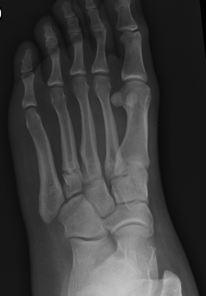Stress fracture
Most people are familiar with the term fracture although associate this with a specific episode of injury. Stress fractures are relatively small breaks in the bone that generally occur after repetitive stress and therefore come on more gradually. Usually there is not a history of a specific traumatic incident.
Unlike traumatic fractures, they rarely result in displacement of the bone (i.e. the two bits of bone come apart and move in relation to one another) and therefore they do not penetrate the skin (compound fracture).
Stress fractures can occur anywhere in the body and in any bone in the foot. The most common site is in the metatarsals. Metatarsal stress fractures are often termed March fractures because they were common amongst soldiers.
What causes stress fractures
Generally, stress fractures result from repetitive loading (i.e. running, marching, sport etc.) although some bone diseases can pre-dispose to thin bones which therefore fracture more easily.
In women, high levels of sports activity can stop the menstrual cycle (amenorrhea) which can pre-dispose to osteoporosis (thinning of the bone) and cause an increase risk of stress fracture.
Will it get worse?
It is important to rest if a stress fracture is suspected, if the area is protected they can settle with time although many people seek help because of the pain.
What are the common symptoms?
- Significant pain in the region
- There are often no signs but there may be some swelling
- Difficulty in shoes
- Difficulty in walking / exercise
- Only painful on activity
How is it recognised?
Clinical examination and a detailed history allow diagnosis. X-rays help to evaluate any obvious stress fracture although these are often normal. More detailed scans may be required for diagnosis especially in chronic cases.
What can I do to reduce the pain?
There are several things that you can do to try and relieve your symptoms:
- Rest the area and stop sporting activity
- Wear good fitting shoes with adequate support and cushioning
- Avoid high heels
- You can try a protective pad
- Custom orthotics
The way in which your foot loads during walking can place increased stress on the foot. Special shoe inserts can help to control foot movement. Orthoses can help to reduce excessive motion and reduce symptoms whilst the bone is healing. In some instances immobilisation in a cast or walking boot is required.
Will this cure the problem?
In the majority of cases, conservative care allows the bone to heal and normal activity can then be resumed.
Very occasionally surgery is necessary to stabilise the fracture site. This may be by placing a small bone screw across the fracture or using a bone plate to stabilise the bone. If the fracture fails to heal (non union), the area of fractured bone may need to be removed and some healthy bone from another apart of the body to be grafted into the site.
Be sociable..share!




